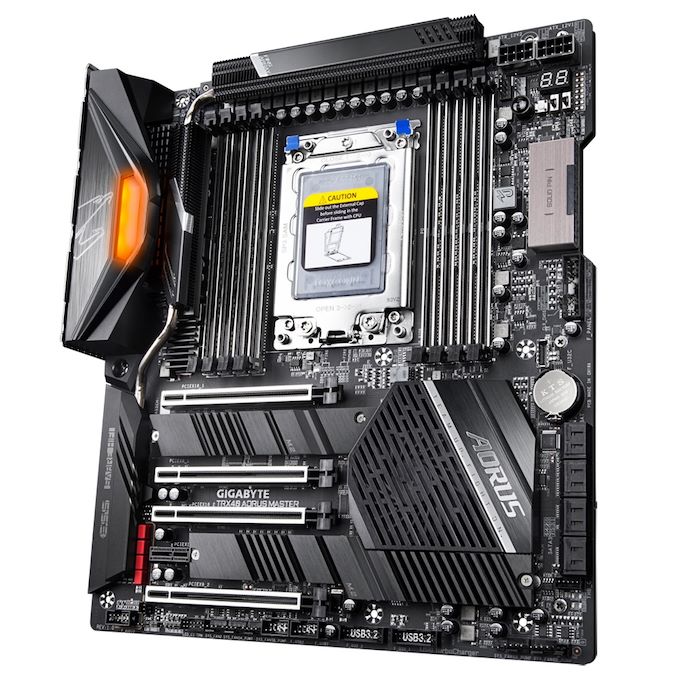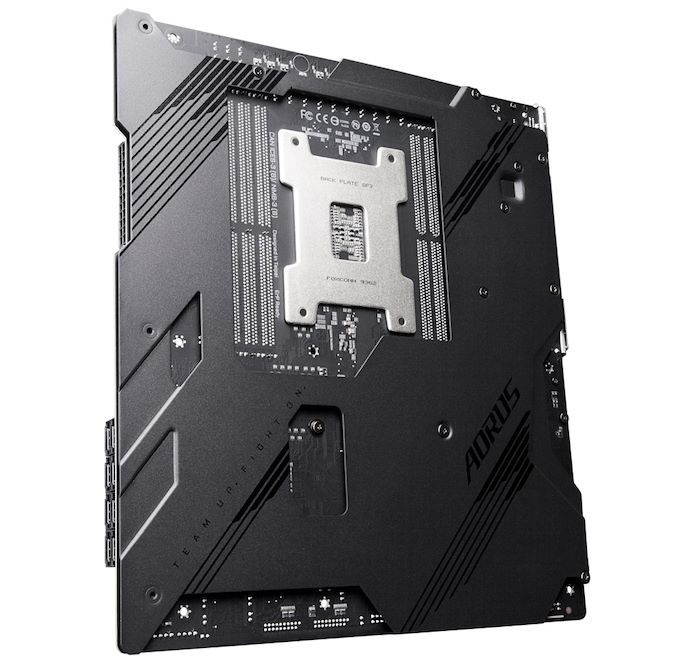The AMD TRX40 Motherboard Overview: 12 New Motherboards Analyzed
by Gavin Bonshor on November 28, 2019 9:00 AM EST- Posted in
- Motherboards
- AMD
- MSI
- Gigabyte
- ASRock
- Asus
- TRX40
- Threadripper 3000
- Castle Peak
GIGABYTE TRX40 Aorus Master
The GIGABYTE TRX40 Aorus Master sits below the TRX40 Aorus Xtreme in the product stack and combines a similar style, in a slightly smaller, but still larger than normal E-ATX PCB. Still retaining the high-end feel, the TRX40 Master is using an E-ATX PCB which is crammed with good quality controllers. The most notable features include support for DDR4-4400 and 256 GB, a pair of Ethernet ports on the rear panel including an Aquantia 5 G controller, Intel's AX200 Wi-Fi 6 wireless interface, and a beefy 16-phase CPU power delivery.
Starting from the top, the GIGABYTE TRX40 Aorus Master has eight memory slots in two banks of four on either side of the sTRX4 socket with support for DDR4-4400 and up to 256 GB in total. Taking a slightly more basic approach to the aesthetics, the rear panel cover does include integrated RGB LEDs, with black heatsinks on a black PCB. The large black aluminium power delivery heatsinks which are interconnected via a heat pipe are cooling a 16-phase power which consists of an Infineon XDPE132G5C 16-phase PWM controller, with sixteen Infineon TDA21472 70 A power stages. Providing power to the CPU is two 8-pin 12 V ATX power connectors which are located in the top right-hand corner.
Also at the top right-hand corner of the board is a two-digit LED debug, while below this is a right-angled 24-pin motherboard power connector. For PCIe devices, there are four full-length PCIe 4.0 slots which operate at x16/x8/x16+x8 and a single PCIe 4.0 x1 slot. The TRX40 chipset heatsink is actively cooled just as we saw with X570. For storage, the GIGABYTE TRX40 Aorus Master has three PCIe 4.0 x4 M.2 slots which include M.2 heatsinks for each slot, and there are eight SATA ports with support for RAID 0, 1, and 10 arrays.
Like with the GIGABYTE TRX40 Aorus Xtreme, the TRX40 Aorus Master also includes a large black metal backplate which will add extra weight to the board. The backplate displays the motto 'Team Up, Fight On' which is more of a gaming term, which is understandable given the boards Aorus branding. The TRX40 Aorus Master includes dual BIOS with a switch which allows users to select between the two, and for cooling, there is a total of eight 4-pin headers. These are split into one for a CPU fan, one dedicated for a water pump, and six for chassis fans.
On the rear panel are five USB 3.1 G2 Type-A, one USB 3.1 G2 Type-C, and two USB 2.0 ports. There are two Ethernet ports with one controlled by an Aquantia 5 G, and the other by an Intel Gigabit Ethernet controller. This model also includes Intel's AX200 Wi-Fi 6 wireless interface and also adds BT 5.0 connectivity too. To the left-hand side is a Clear CMOS and Q-Flash Plus switch, with the five 3.5 mm audio jacks and S/PDIF optical output handled by a Realtek ALC4050H and Realtek ALC1220 audio codec pairing. The TRX40 Aorus Master also includes a Realtek ALC4050H and ESS Sabre 9218 DAC for the front panel audio.
The GIGABYTE TRX40 Aorus Master is still a high-end TRX40 motherboard and with an MSRP of $499, it isn't exactly cheap, but it does offer users plenty of good quality features on AMD's new HEDT platform. While the Aorus brand is mainly targeted at gamers, the TRX40 Aorus Master looks to combine elements from both the enthusiast and gaming sides, to create a reasonably priced multi-purpose model for all looking to use and unlock all of the power within the Threadripper 3000 processors.













109 Comments
View All Comments
Smell This - Thursday, November 28, 2019 - link
Still just a bit bummed .... that 1st/2nd Gen TRs have been left hangin'
As we roll into 2020, we gotta love where AMD is going BUT, here's hoping that Dr Su does not make the same mistakes on HEDTs that Chipzillah has been notorious in making in the past. With DDR5 on the horiZen, could sTRX4 be yet another *2 and Done* in the next 18 months?
I'm all for $800 mobos -- just as long as they don't become $50 moo-boards in January, 2021.
Spunjji - Friday, November 29, 2019 - link
Based on prior experience of AMD processors, it seems more likely that they'd have to offer new boards for DDR5 support but allow the new processors to run in older boards with DDR4.eek2121 - Friday, November 29, 2019 - link
Chances are that the TRX* series of boards will end in 2021 (or 2022 at the latest), when DDR5 is expected to roll out along with possibly Zen 5 (if 2022). That being said, I have an X399 board and a 1950X. I don't see a need to upgrade yet. I may eventually pick up a 2950X next year, but I'm hanging onto this platform. It games pretty much all current games at 4k, with the majority at maximum or high details (even on a 1080ti), and it's excellent for the development and content creation workloads that i do. Don't let the listed benchmarks fool you, the 1950X is capable of much more. Running Linux brings a rather large performance increase due to better thread scheduling among other things. I have no problems running GTA V or any other games that I play, at full 4k and maximum details.Llawehtdliub - Saturday, November 30, 2019 - link
At 30fpsscineram - Wednesday, December 4, 2019 - link
300.masmosmeaso - Thursday, November 28, 2019 - link
question,is the amount of phases important when it comes to performance or having more devices on the motherboard ? if so how many is overkill for these motherboards ?
Hul8 - Thursday, November 28, 2019 - link
Those power delivery components are only for the CPU package, and take all their power input from the auxiliary CPU power connectors (usually 8-pin, 8+4 or 8+8-pin these days).The rest of the motherboard get their power thru the 24-pin.
eek2121 - Friday, November 29, 2019 - link
More phases typically means better performance (thermals, quality of power, power limits) from the CPU, unless the vendor cheaps out on VRMs. I'd stay away from any board offering only a single 8-pin, as that can be a sign they are using lower quality VRMs, fewer phases, etc. Contrary to popular belief, phase doublers don't really hurt anything. A few in the youtube community have tested this, both with a CPU and also with a CPU 'emulator' that plugs into the socket and measures power output.Hul8 - Tuesday, December 10, 2019 - link
The question was about "devices on the motherboard", which I assume means things other than the CPU. That's why I pointed out that the phases are irrelevant to the question.Dragonstongue - Thursday, November 28, 2019 - link
just to say suchjust "cause" the box label as 280w TDP, this does not automatically mean it USES 280w (I am sure Intel or NVDA likely many many others) will lambast the crud out of AMD for this, without giving the "full story"
eg. Intel will say "our product X only is TDP of Y vs this massive 280w number, choose us, save the world" then when the user actually uses said "product X" they find out either A is much much slower than all review sites list it is and/or B, it shoots ACTUAL power use through the roof therefore not matching the "claims" of said product X TDP being "better" than TR gen 3 280w "listed" TDP
Intel, NVDA have far more proven themselves on "fibbing" their numbers to make the sales than AMD has "overall" over the many years I have been involved with (consumer or otherwise) in computing
............
Thanks for the review overall, at least it seems the various "partners" are not being overly foolish in terms of pricing and feature set, MSI IMO even "better" than some of the others (such as ASUS)
I truly hope these turn out to be the "cat's meow" for those whom can afford and use them, it helps AMD, helps their partners, the long run, helps us all
(^.^)